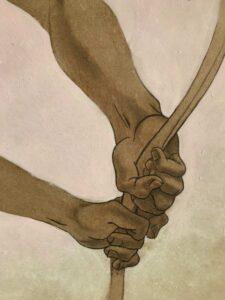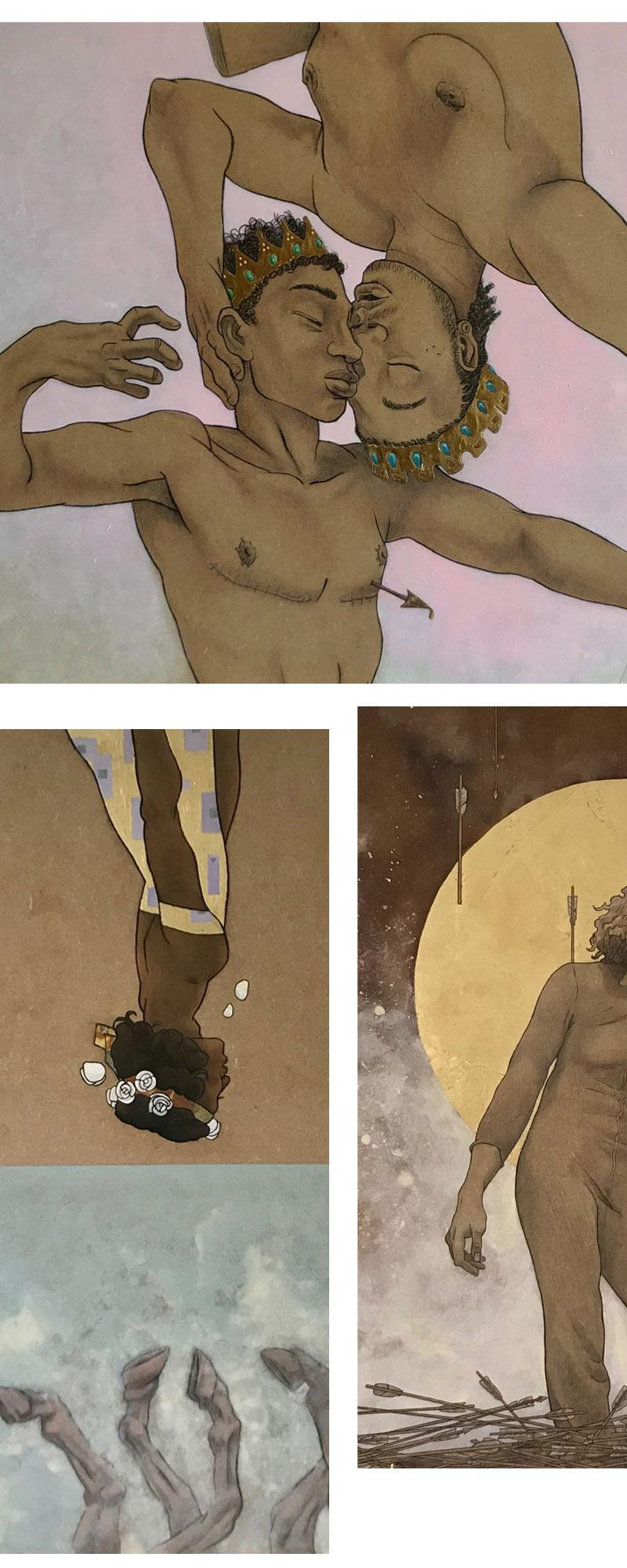painting
 2022 winner of the Daniel & Nina Carasso Foundation x Cité internationale des Arts de Paris, TRANS RESILIENCE is a series of portraits on wood with gold leaf, a representation of manifested transgender bodies, whose skins merge with the raw material.
2022 winner of the Daniel & Nina Carasso Foundation x Cité internationale des Arts de Paris, TRANS RESILIENCE is a series of portraits on wood with gold leaf, a representation of manifested transgender bodies, whose skins merge with the raw material.
In recent years, transgender lives have increasingly been placed at the center of political and media debates. These stories are almost always dominated by stereotypes and, in most cases, ignore the voices of the individuals involved. As a result, trans people have quickly become a new kind of scapegoat, subject to discriminatory laws around the world: hundreds of people are killed each year and just as many commit suicide because of transphobia.
In the West, the idea that being trans is a fashion or a modern-day illness has also spread. To counter this misconception, the LGBTQ+ community is increasingly celebrating its trans ancestors: we all have gender non-conforming ancestors gender non-conformingwith a name and a story.
Jul Maroh's Trans Resilience project aims to highlight these lives. Jul Maroh began their gender transition in 2018. Their creative process has been developing for over ten years, through various narrative projects that overlap in permeable ways. Their common thread is the exploration of the no man's land that exists in our lives between the intimate and the collective, that zone of tension between personal desires and social expectations. Thus, in 2021, their trans experience gave rise to the desire to create a series of portraits: icons from the history of the LGBTQ+ community, already considered ancestors, but also living trans people: ancestors for future generations.
Through these portraits, emerges the issue of resilience in the lives of trans people. Here, resilience is not presented as a series of acts of courage or suffering, positive or negative, but as an intrinsic reality of trans lives within an imperialist and binary society.
To tell this experience, the artist draws on the mythological and hybrid figure of Chiron – the wounded healer – whose attributes run through all the paintings on display: bows, arrows, crowns, scars of operated flesh, hooves.
The intention of this series of large-scale portraits (all paintings measure 1m²), and the use of symbolic codes, is to create a narrative that opens up new fields of experience – whether sensory, organic, or political – for the viewer. The aim is to expose both the fragility and strength of transgender lives, often on the margins of society because their embodiment challenges imposed binary roles.
To do this, the artist uses various mediums, including acrylic paint, grease pencils and gold leaf: like the kintsugi technique in Japan, its symbolic objective is to restore the dignity and sacredness of these subjectivities, just as to heal their wounds with golden bandages.
This project having received support from the Cité internationale des arts in Paris and the Daniel & Nina Carasso Foundation in 2022, Jul Maroh was able to push it towards other fields of expression during their residency at the Cité. For example, on the occasion of the TDOR (Trans Day Of Remembrance) week, Maroh guided a collective ritual for the public among the paintings on display, during one of the famous open studios of the structure.
During this ceremony, and by following the artist's voice through a collective inner journey, those present were able to honor one of their transgender ancestors and invoke resilience, at the heart of the project, through symbolic gestures and recitations. The installation in the studio—completed with a mirror, a poem, and objects linked to the figure of the centaur Chiron—facilitated an experience of contemplation and connection with wounded parts of the self brought about by patriarchy and imposed social norms.
These notions of sacredness were able to be further developed in 2024 during the first solo show of the project during the cultural festival Gender Bender and the festival Ad Occhi Aperti, where Jul Maroh and the teams present made the place a temple of softness and forcefulness, for these trans lives on the margins of norms.





